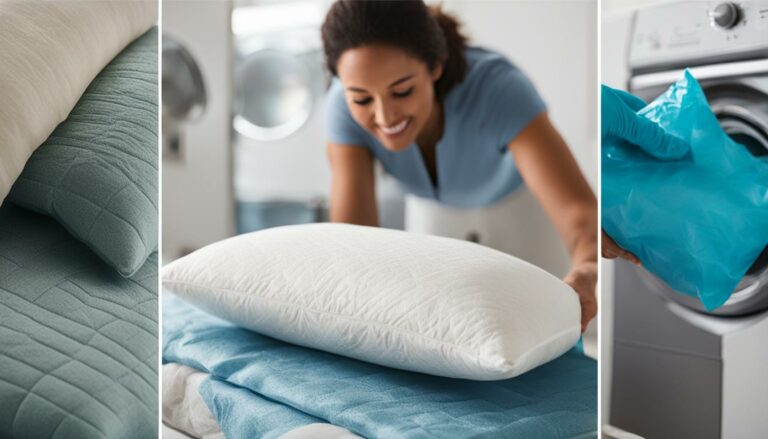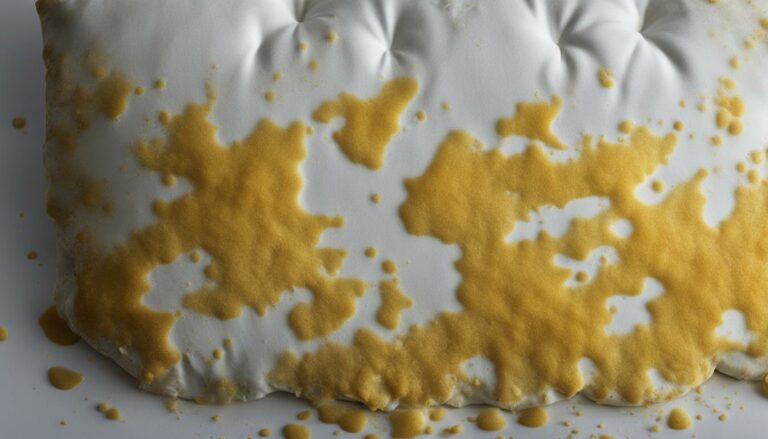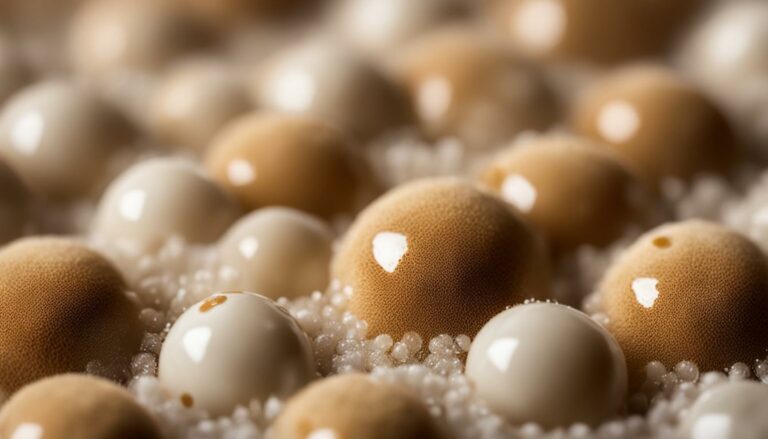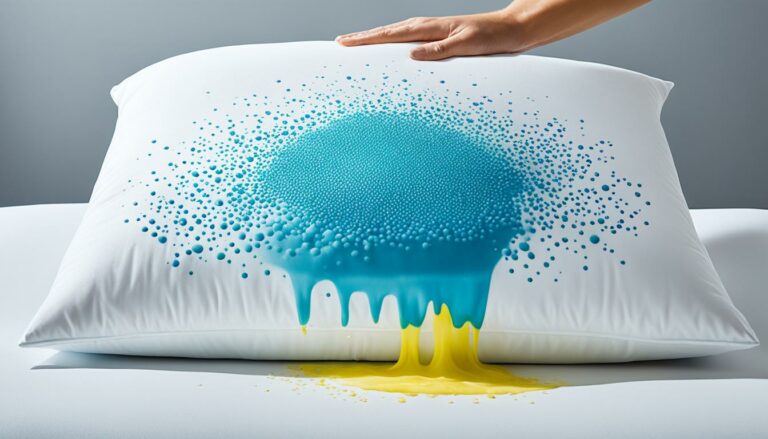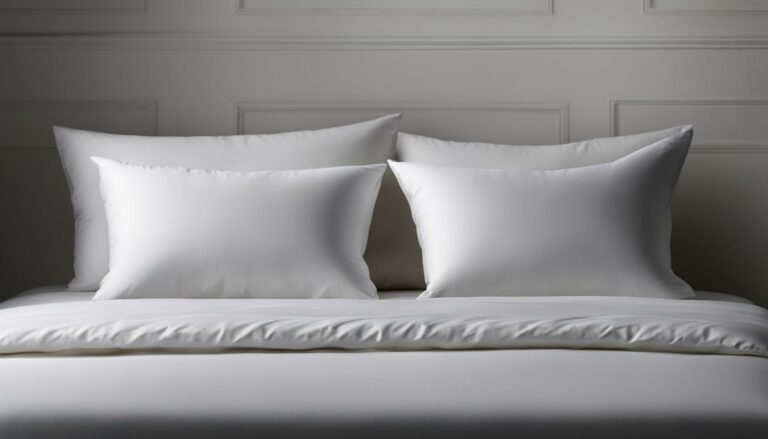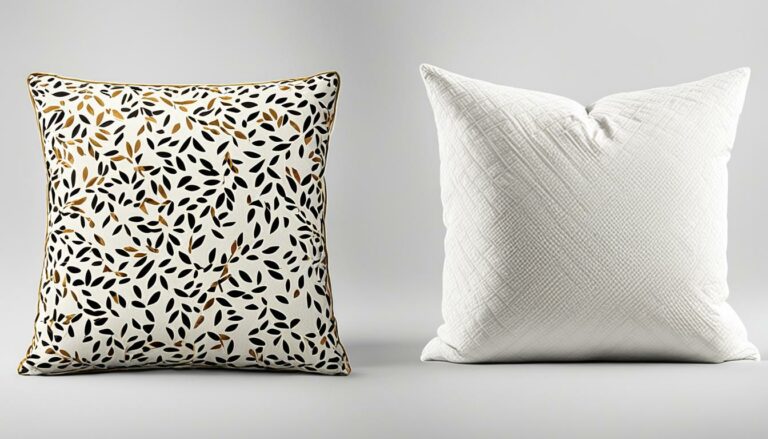Banish Bed Bug Stains on Pillows Easily!
Eric Christie stands as a luminary in the bedding industry, with a career spanning nearly four decades since the early 1980s. His journey through the world of bedding has seen him wear many hats – a manufacturer, designer, and retailer, showcasing his versatility and expertise in Read more...
pillowsandbedsheets.com and its partners may earn a commission if you purchase a product through one of our links
Dealing with bed bug stains on your pillows can be a nightmare. But fear not, we have effective solutions to help you remove those unsightly stains and enjoy a spotless and comfortable sleep. In this article, we will share tips, tricks, and DIY methods to help you eliminate bed bug stains from your pillows. Say goodbye to those pesky stains and say hello to a restful slumber!
Key Takeaways:
- Bed bug stains on pillows can be easily removed with the right strategies.
- Understanding the biology and behavior of bed bugs helps in preventing infestations.
- Preparation is key before treating bed bug stains, including decluttering and deep cleaning.
- There are effective home remedies and professional treatments available for eliminating bed bug stains.
- Preventive measures such as regular vacuuming and proper laundering can help maintain a bed bug-free environment.
What are Bed Bugs?
Before we dive into how to remove bed bug stains from pillows, let’s understand what bed bugs are. Bed bugs are small, flat, oval-shaped insects that feed on blood. They are brown in color and about 5mm in size, making them barely visible to the naked eye.
Unlike other insects, bed bugs cannot fly or jump. Instead, they crawl out of their hiding spots at night, attracted by the warmth of human bodies, to feed on blood. Their preferred feeding areas are typically exposed skin, such as the face, neck, arms, and hands.
Females are capable of laying up to 250 eggs during their lifetime, which are oval and white in color. These eggs are extremely tiny, measuring about 1mm in length, making them difficult to detect without careful inspection.
Bed bug bites can cause discomfort and some people may have allergic reactions to them. Their bites often result in red, itchy welts that appear in a linear or clustered pattern.
“Bed bugs are resilient insects that are hard to eliminate once they infest your home. It’s important to take immediate action to prevent further infestations.”
Now that we have a better understanding of bed bug biology and the problems they can cause, let’s move on to the strategies for removing bed bug stains from pillows and improving your sleep environment.
Causes and Signs of Bed Bugs
Bed bugs can become a nuisance in your home through various means. Contrary to popular belief, a dirty or unclean environment is not the main cause of bed bugs. These pests are attracted to humans and animals as a source of blood, so any place with a potential food source is ideal for them to thrive.
If you suspect a bed bug infestation, it’s important to be aware of the signs. Look out for the following indicators:
- Bites on the skin: Bed bug bites are small, red, and itchy, usually appearing in a cluster or a line on exposed areas of the body.
- Small black spots on bedsheets: These spots are bed bug feces and are often found near their hiding places.
- Bed bug shells: As bed bugs grow and molt, they shed their exoskeletons, leaving behind empty shells.
- A musty smell in the bedroom: Bed bugs release pheromones, which can create a distinctive, unpleasant odor in infested areas.
- Blood spots on the sheets: After feeding, bed bugs may leave behind blood stains on your bedding.
If you notice any of these signs, it’s likely that you have a bed bug problem. Taking prompt action to address the infestation is crucial to prevent it from spreading further.
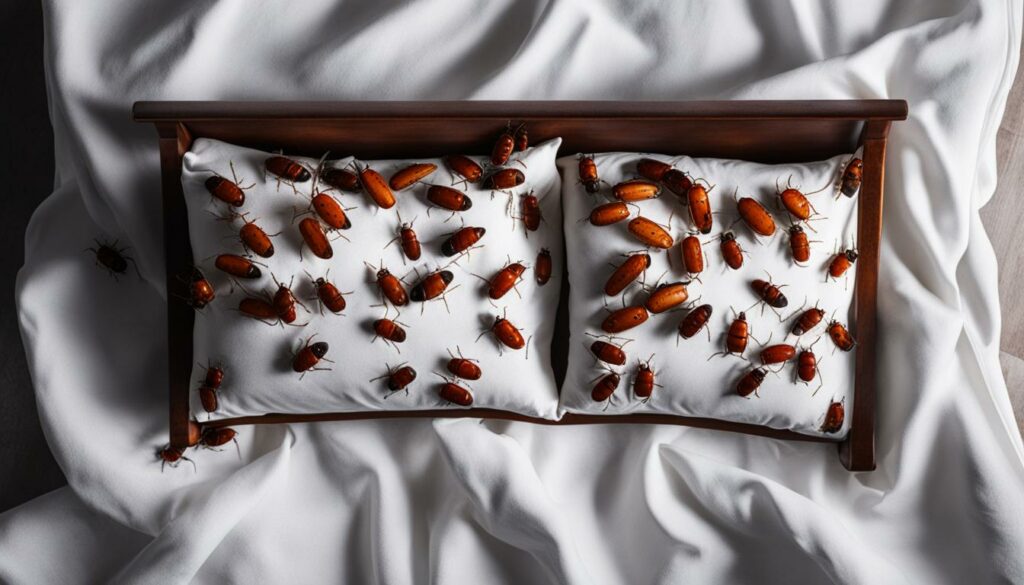
It’s important to note that bed bugs are resilient pests, and professional help may be necessary to completely eliminate them from your home.
Preparing for Bed Bug Treatment
Before you begin treating bed bugs, it’s essential to prepare your home for the treatment process. Follow these steps to ensure a thorough and effective treatment:
- Remove Clutter: Start by removing clutter from your bedroom and other infested areas. Bed bugs can hide in cardboard boxes, clothes, and other belongings, so it’s important to replace cardboard boxes with sealed plastic containers and seal all your clothing in plastic bags.
- Deep Cleaning: Deep clean all items that could be infested, such as clothing and sheets. Heat treat them in a dryer at the highest heat setting for at least 30 minutes, or freeze them for several days in a freezer below 0°F (-18°C). This will help kill any bed bugs or eggs that may be present.
- Vacuuming: Vacuum the entire area, including the mattress, headboard, slats, and surrounding areas. Pay special attention to seams, crevices, and cracks where bed bugs may hide. Use a vacuum with a high-efficiency particulate air (HEPA) filter to ensure that captured bed bugs are not released back into the air.
By removing clutter, deep cleaning, and vacuuming thoroughly, you’ll create an environment that is less hospitable for bed bugs and increase the effectiveness of the treatment process.
Home Remedies for Bed Bug Stains
If you prefer a DIY approach to removing bed bug stains from pillows, there are several effective home remedies you can try. These remedies are budget-friendly and can help you eradicate bed bugs without the need for professional assistance. Let’s explore these home remedies in detail:
1. Starving the Bed Bugs
If you want to starve the bed bugs and eliminate them naturally, start by thoroughly vacuuming your mattress. Be sure to vacuum every nook and cranny, paying extra attention to the seams and crevices. After vacuuming, seal your mattress in airtight Ziploc bags for about a week. This way, the bed bugs won’t have access to a blood meal, and they will eventually starve to death.
2. Diatomaceous Earth
Diatomaceous earth is a natural powder that can effectively kill bed bugs by dehydrating them. Sprinkle a generous amount of diatomaceous earth onto the affected area, such as your pillows, and leave it for a few days. Then, thoroughly vacuum the powder and repeat the process until all bed bugs are eradicated. Remember to use food-grade diatomaceous earth that is safe for use around humans and pets.
3. Bicarbonate of Soda
Bicarbonate of soda, also known as baking soda, can be used to eliminate bed bug stains and odors. Sprinkle a generous amount of baking soda onto your pillows and let it sit for a few hours. The baking soda will help absorb any moisture and neutralize the odor caused by bed bug stains. Afterward, vacuum the baking soda thoroughly.
4. Tea Tree Essential Oil
Tea tree essential oil has natural properties that can repel bed bugs and prevent further infestations. Dilute a few drops of tea tree essential oil with water and spray it onto your pillows and other infested areas. The strong scent of tea tree oil will act as a deterrent for bed bugs, making them less likely to approach.
5. Vinegar and Rubbing Alcohol
Vinegar and rubbing alcohol are effective disinfectants and can help eliminate bed bug stains. Mix equal parts vinegar and water in a spray bottle, and spray it onto your pillows. Vinegar not only helps remove the stains but also eliminates any odor associated with bed bugs. Rubbing alcohol can also be used by itself to kill bed bugs on contact. Remember to test these solutions on a small, inconspicuous area of your pillows before applying them extensively.
6. Borax
Borax, a common household cleaning agent, can be used to kill bed bugs and remove their stains. Sprinkle borax onto your pillows and other infested areas, and allow it to sit for a few hours. Then, vacuum the borax thoroughly to remove any remnants of bed bugs and their stains.
Remember, while these home remedies can be effective, severe bed bug infestations may require professional pest control assistance. Consider consulting with an expert if the infestation persists or worsens despite your DIY efforts.
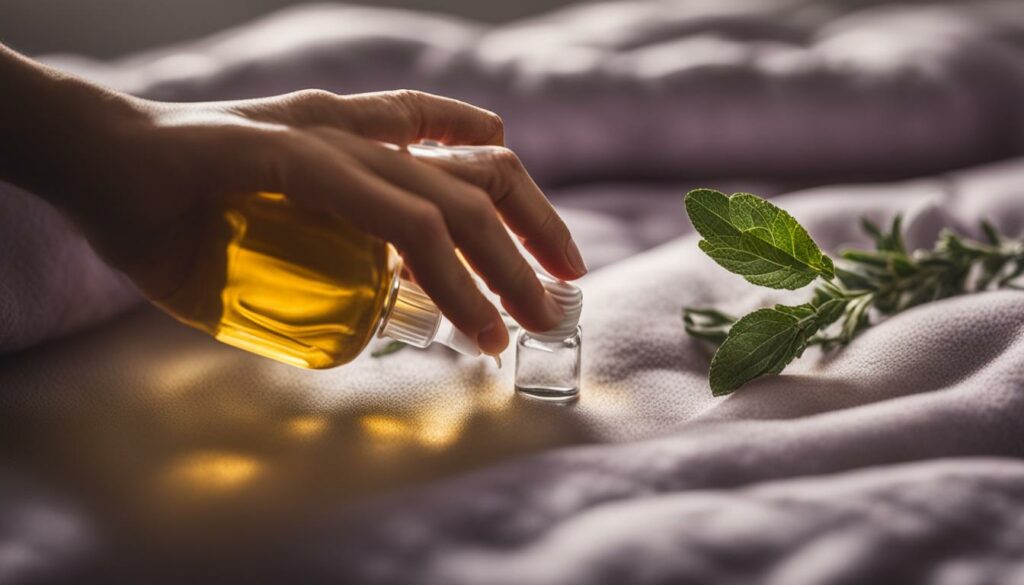
Using Pesticides for Bed Bug Treatment
When it comes to eliminating bed bugs quickly and efficiently, using pesticides can be a viable solution. However, it’s important to handle pesticides with caution, as they can be harmful if not used properly.
Before applying any bed bug pesticides, it’s crucial to prepare the treatment area. Start by removing clutter and thoroughly vacuuming the infested areas, including mattresses, furniture, and baseboards. This helps to create a clean and optimized environment for the pesticide application.
When selecting a pesticide, make sure to choose one specifically designed for bed bug treatment. It’s important to follow the instructions provided by the manufacturer carefully. This includes wearing protective clothing such as gloves and masks, ensuring proper ventilation in the treatment area, and applying the pesticide at the recommended dosage.
While there are various bed bug pesticides available on the market, consulting with a professional pest control company is highly recommended. Professional pest control experts have the knowledge, expertise, and experience to effectively apply pesticides and ensure that the treatment is safe and successful.
Professional pest control treatments may involve multiple visits to completely eradicate the bed bug infestation. This is because bed bugs can be resilient and challenging to eliminate entirely. A thorough and comprehensive approach is necessary to ensure the complete removal of these pests.
Pesticide Application Precautions:
- Read and follow the pesticide label instructions carefully.
- Wear appropriate protective clothing, such as gloves and masks, during the application.
- Ensure proper ventilation in the treatment area.
- Keep children and pets away from treated areas until the product has dried completely.
“Using pesticides for bed bug treatment can be an effective method to eliminate these pests. However, it’s essential to prioritize safety and consult with professionals for the most efficient and reliable results.”
Remember, the improper use of pesticides can pose health risks and may not effectively eliminate the bed bug infestation. Seeking professional assistance from pest control experts ensures a safer, more efficient, and successful treatment process.
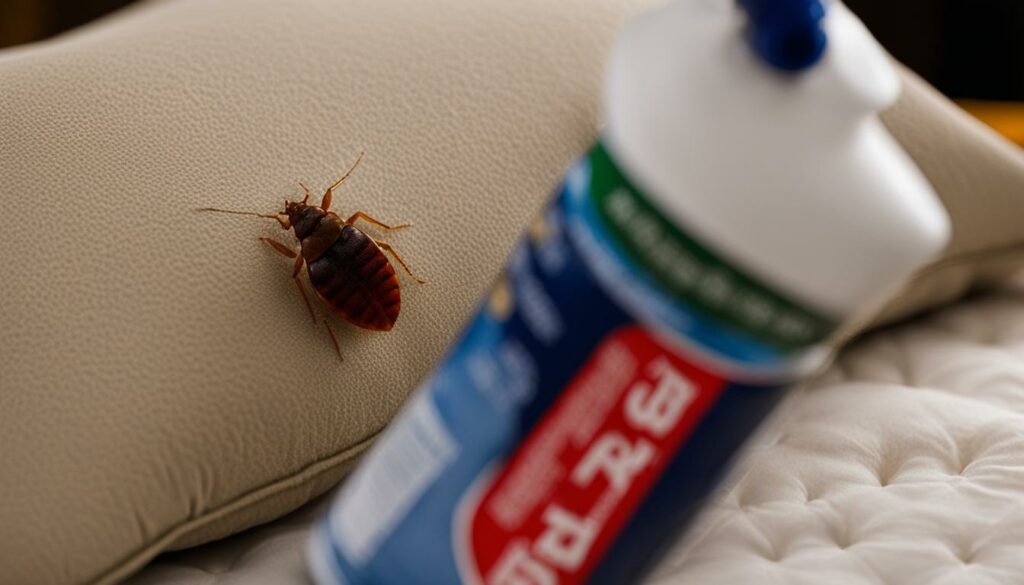
**Keywords: bed bug pesticides**.
| Pesticide Name | Active Ingredient | Application Method |
|---|---|---|
| XYZ Pest Control | Pyrethrins, piperonyl butoxide | Spray, aerosol |
| ABC Bed Bug Killer | Deltamethrin, pyrethrins | Liquid concentrate, spray |
| DEF Bed Bug Powder | Diatomaceous earth | Powder |
Here are some commonly used bed bug pesticides:
- XYZ Pest Control: This pesticide contains pyrethrins and piperonyl butoxide as active ingredients. It is available in spray and aerosol forms, making it easy to apply to affected areas.
- ABC Bed Bug Killer: This pesticide contains deltamethrin and pyrethrins. It is available as a liquid concentrate and spray, providing effective control against bed bugs.
- DEF Bed Bug Powder: This pesticide is based on diatomaceous earth, a natural and non-toxic substance that dehydrates and kills bed bugs. It is commonly used in powder form, making it suitable for targeted application.
Remember, always read and follow the instructions provided by the manufacturer when using pesticides. If you’re unsure about the appropriate pesticide to use or the application process, consult with a professional pest control company.
Preventing Bed Bug Infestations
Prevention is key when it comes to bed bugs. By taking proactive measures, you can significantly reduce the likelihood of bed bug infestations in your home. Here are some effective steps to prevent bed bugs from settling in:
- Vacuum regularly: Regular vacuuming helps remove any stray bed bugs and their eggs from your home. Pay close attention to areas where bed bugs are likely to hide, such as mattresses, bed frames, and cracks in furniture.
- Check second-hand furniture: If you’re considering purchasing second-hand furniture, make sure to thoroughly inspect it for any signs of bed bugs. Look for dark spots, shed skin, or live bugs. It’s better to be safe than sorry!
- Take precautions when laundering: If you share laundry facilities, it’s important to take precautions to avoid picking up bed bugs from others. Transport your clothes in sealed plastic bags, and avoid leaving them out for extended periods.
By following these prevention methods, you can create an environment that is unfriendly to bed bugs and reduce the chances of infestations.
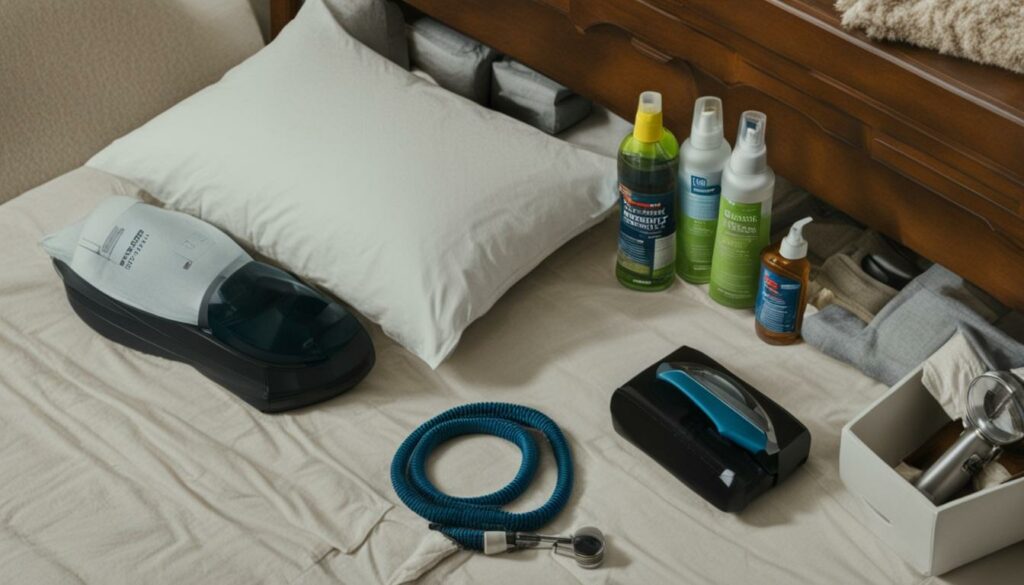
Comparison of Prevention Methods
| Prevention Method | Effectiveness | Difficulty | Cost |
|---|---|---|---|
| Vacuuming regularly | High | Easy | Low |
| Thoroughly checking second-hand furniture | High | Moderate | Low |
| Taking precautions when laundering | Moderate | Easy | Low |
Remember, prevention is always better than dealing with a bed bug infestation. By implementing these prevention methods, you can sleep peacefully knowing that your home is protected.
Washing Pillows to Remove Bed Bug Stains
To remove bed bug stains from pillows, it’s essential to wash them regularly. Most pillows can be washed in the washing machine, using a mild detergent and following the instructions on the pillow’s label. Down and feather pillows can be machine-washed, while memory foam pillows should be hand-washed in a bathtub with warm water and mild detergent. In between machine washes, you can freshen up the pillows using white vinegar or baking soda, which act as natural disinfectants and deodorizers.
Spaying white vinegar on the pillows can help repel dust mites and keep them fresh. Simply fill a spray bottle with white vinegar and mist the pillows lightly. Let them air dry completely before using them again.
Another option is to sprinkle baking soda on the pillows, which helps absorb odors and remove any lingering stains. Leave the baking soda on the pillows for a few hours or overnight, then vacuum it off using a brush attachment. Your pillows will be refreshed and free from bed bug stains.
Drying and Maintaining Pillows
After washing pillows, proper drying is essential to maintain their cleanliness and extend their lifespan. Most pillows can be placed in the tumble dryer on an air-dry setting or at the lowest temperature possible. However, memory foam pillows should be air-dried naturally to avoid damage. It’s essential to ensure pillows are fully dried before using or storing them to prevent mold and mildew growth. To fluff up pillows and prevent them from going lumpy, you can add a tennis ball to a sock and place it in the dryer with the pillows.
Benefits of Proper Drying
- Ensures pillows remain clean and hygienic
- Prevents mold and mildew growth
- Extends the lifespan of pillows
- Maintains the pillow’s shape and fluffiness
Proper drying is crucial to avoid any moisture buildup that can lead to the growth of mold and mildew. Mold and mildew not only cause unpleasant odors but can also pose health risks. It’s important to note that different pillow materials require different drying methods. While most pillows can be placed in the dryer, it’s essential to check the care instructions to ensure the recommended drying method for your specific pillow.
Air-Drying Memory Foam Pillows
- Remove the pillowcase and any protective covers.
- Place the memory foam pillow in a well-ventilated area, away from direct sunlight.
- Allow the pillow to air-dry naturally. This may take several hours or even a full day.
- Periodically fluff the pillow to ensure even drying and prevent it from becoming lumpy.
Memory foam pillows should never be placed in the dryer as the heat can damage the foam, causing it to lose its shape and support. Instead, opt for air-drying to preserve the integrity of the memory foam material.
The Tennis Ball Trick
To prevent pillows from clumping together or losing their shape during the drying process, you can use the tennis ball trick. Simply place a few tennis balls in a clean sock and tie a knot to secure them inside. Add the sock with the tennis balls to the dryer along with the pillows. As the dryer tumbles, the tennis balls will gently fluff the pillows, ensuring they retain their shape and loft.
Remember, always follow the care instructions provided by the pillow manufacturer to ensure the best drying method for your specific pillow type. By properly drying and maintaining your pillows, you can enjoy fresh, clean, and comfortable sleep night after night.
Professional Help for Bed Bug Stains
If DIY methods don’t yield the desired results or you prefer professional assistance, consider hiring pest control experts or mattress cleaning services. These professionals have the knowledge, experience, and specialized tools to effectively remove bed bug stains and treat infested areas.
They can offer treatments such as:
- Steam cleaning: Using high-temperature steam to kill bed bugs and remove stains from mattresses and other affected surfaces.
- Chemical treatments: Applying safe and effective pesticides to eliminate bed bugs and their stains.
- Mattress encasements: Using protective covers to prevent bed bugs from accessing your mattress and creating new stains.
By opting for professional help, you can save time and effort while ensuring a thorough and effective treatment. These experts have the expertise to identify the severity of the infestation and tailor their approach accordingly. They can also provide you with valuable advice on preventing future bed bug problems.
Remember, it’s crucial to choose reputable and reliable professionals. Look for companies that specialize in pest control or mattress cleaning services. Read reviews and ask for recommendations to ensure you’re hiring qualified experts who will deliver satisfactory results.
With professional help, you can say goodbye to bed bug stains and enjoy a clean, pest-free home.
Maintaining a Bed Bug-Free Environment
Once you have successfully removed bed bug stains and treated the infested areas, it’s crucial to maintain a bed bug-free environment. By following these simple steps, you can ensure that your home remains free from these pesky pests and enjoy a peaceful sleep.
Clean Bedding
Regularly cleaning and changing your bedding is an essential part of maintaining a bed bug-free environment. Washing your bedding in hot water and drying it on high heat kills any remaining bed bugs and their eggs. It’s recommended to wash your bedding at least once a week to prevent infestations.
Regular Vacuuming
Vacuuming your home on a regular basis is key to keeping bed bugs at bay. Focus on areas where bed bugs are likely to hide, such as mattresses, box springs, and furniture seams. Use a vacuum cleaner with a HEPA filter to ensure that any captured bed bugs are effectively removed.
Preventive Measures
Taking preventive measures is crucial in maintaining a bed bug-free environment. Inspect any second-hand furniture or clothing before bringing them into your home, as these items can be potential sources of bed bug infestations. Additionally, practicing good hygiene, such as regularly washing and drying your clothes, can help prevent bed bugs from hitching a ride.
Tip: Remember to seal any gaps or cracks in your walls, floorboards, or furniture to prevent bed bugs from entering or escaping.
By incorporating these habits into your routine, you can significantly reduce the risk of bed bug infestations and maintain a clean and comfortable living space.
| Benefits of Maintaining a Bed Bug-Free Environment |
|---|
| Peaceful sleep |
| Reduced risk of bed bug bites |
| Minimized chances of infestations |
| Improved overall hygiene |
| Enhanced mental well-being |
Say Goodbye to Bed Bug Stains for a Restful Sleep
Are those stubborn bed bug stains on your pillows keeping you up at night? Say goodbye to those unsightly marks and get ready for a restful sleep. In this article, we’ve shared tips and techniques to effectively eliminate bed bug stains from your pillows. Whether you prefer a DIY approach or professional assistance, there are options to suit your needs and the severity of the infestation.
To prevent future bed bug infestations, it’s important to be proactive. Keep your surroundings clean, practice good hygiene, and regularly inspect your home. By maintaining cleanliness and regularly washing bedding, you can create an environment that is inhospitable to bed bugs. Regular vacuuming and preventive measures can also help in keeping these pests at bay.
With the right approach, you can banish bed bug stains and wake up to a spotless, comfortable sleep every night. So, say goodbye to bed bug stains and say hello to sweet dreams!
FAQ
What are bed bugs?
Bed bugs are small, flat, oval-shaped insects that feed on blood. They are brown in color, about 5mm in size, and can crawl out of their hiding spots at night to feed on human blood.
What are the signs of a bed bug infestation?
The signs of a bed bug infestation include bites on the skin, small black spots on bedsheets (bed bug feces), bed bug shells, a musty smell in the bedroom, and blood spots on the sheets.
How can I prepare for bed bug treatment?
To prepare for bed bug treatment, remove clutter from your bedroom and other infested areas, deep clean infested items, and vacuum the entire area, including the mattress, headboard, slats, and surrounding areas.
Are there any home remedies for removing bed bug stains?
Yes, some home remedies for removing bed bug stains include starving the bed bugs by vacuuming the mattress and sealing it in bags, using diatomaceous earth, bicarbonate of soda, tea tree essential oil, vinegar, rubbing alcohol, and borax.
Can I use pesticides for bed bug treatment?
Yes, you can use pesticides for bed bug treatment, but caution must be exercised. It’s recommended to consult a professional pest control company for the safest and most effective pesticide application.
How can I prevent bed bug infestations?
To prevent bed bug infestations, vacuum regularly, inspect second-hand furniture before bringing it into your home, and take precautions when laundering your clothes, especially if you share laundry facilities.
How should I wash pillows to remove bed bug stains?
Most pillows can be washed in the washing machine using a mild detergent. Down and feather pillows can be machine-washed, while memory foam pillows should be hand-washed in a bathtub with warm water and mild detergent.
How should I dry and maintain pillows?
Most pillows can be tumble dried on an air-dry setting or at the lowest temperature possible. Memory foam pillows should be air-dried naturally. To maintain fluffiness, you can add a tennis ball to the dryer.
Can I seek professional help for bed bug stains?
Yes, you can hire pest control experts or mattress cleaning services to professionally remove bed bug stains and treat infested areas.
How can I maintain a bed bug-free environment?
To maintain a bed bug-free environment, clean and change your bedding regularly, vacuum your home to remove any stray bed bugs, and practice preventive measures like inspecting second-hand furniture and practicing good hygiene.
How can I eliminate bed bug stains and enjoy a restful sleep?
By following the tips and techniques mentioned in this article, you can effectively remove bed bug stains from your pillows and maintain a bed bug-free environment for a restful sleep.
Eric Christie stands as a luminary in the bedding industry, with a career spanning nearly four decades since the early 1980s. His journey through the world of bedding has seen him wear many hats – a manufacturer, designer, and retailer, showcasing his versatility and expertise in Read more...


